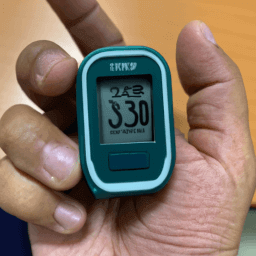What is a Pulse Oximeter
A pulse oximeter is a medical device that measures the oxygen saturation level in the blood. It is a non-invasive and painless way to check how well oxygen is being transported from the lungs to the rest of the body. The device works by shining a light through the fingertip and measuring the amount of light absorbed by the oxygenated and deoxygenated blood. The oxygen saturation level is displayed as a percentage on the device's screen. Pulse oximeters are commonly used in hospitals, clinics, and homes to monitor oxygen levels in patients with respiratory or cardiovascular conditions.
What is a Pulse Oximeter?
A pulse oximeter is a medical device that measures the oxygen saturation level in the blood. It is a non-invasive and painless way to determine how well oxygen is being carried to the extremities of the body, such as the fingers and toes. The device works by shining a light through the skin and measuring the amount of light absorbed by the oxygenated and deoxygenated blood.
How does a Pulse Oximeter work?
A pulse oximeter uses a small clip-like device that is placed on a finger or toe. The device shines two different wavelengths of light through the skin and into the blood vessels. The oxygenated blood absorbs more of one wavelength of light, while the deoxygenated blood absorbs more of the other wavelength. By measuring the difference in the amount of light absorbed, the device can determine the oxygen saturation level in the blood.
Why is a Pulse Oximeter used?
A pulse oximeter is used to monitor the oxygen saturation level in the blood of individuals with respiratory or cardiac conditions. It is commonly used in hospitals, clinics, and homes to monitor patients with chronic obstructive pulmonary disease (COPD), asthma, pneumonia, and other respiratory illnesses. It is also used during surgery and in intensive care units to monitor patients who are on ventilators or receiving oxygen therapy.
Types of Pulse Oximeters
There are two types of pulse oximeters: fingertip and handheld. Fingertip pulse oximeters are small, portable devices that clip onto the fingertip. Handheld pulse oximeters are larger and typically used in hospitals and clinics. They can be used on various parts of the body, such as the finger, earlobe, or toe.
Benefits of using a Pulse Oximeter
A pulse oximeter can provide valuable information about the oxygen saturation level in the blood. It can help detect early signs of respiratory or cardiac problems and prevent complications. It can also help monitor the effectiveness of oxygen therapy and adjust the treatment accordingly. Additionally, it is a non-invasive and painless way to monitor oxygen levels, making it a convenient and easy-to-use device.
Limitations of using a Pulse Oximeter
While a pulse oximeter is a useful tool for monitoring oxygen levels, it has some limitations. It only measures the oxygen saturation level in the blood and does not provide information about the carbon dioxide level or the overall respiratory function. It may also give inaccurate readings in certain conditions, such as low blood pressure, cold fingers, or dark nail polish.
Conclusion
A pulse oximeter is a valuable tool for monitoring the oxygen saturation level in the blood. It is a non-invasive and painless way to detect early signs of respiratory or cardiac problems and adjust the treatment accordingly. While it has some limitations, it is a convenient and easy-to-use device that can provide valuable information for patients and healthcare professionals.
| Types of Pulse Oximeters | Benefits | Limitations |
|---|---|---|
| Fingertip | Small and portable | May give inaccurate readings in certain conditions |
| Handheld | Can be used on various parts of the body | Only measures oxygen saturation level in the blood |
| By www.zelect.in | ||
Sharing is caring!
Facebook Twitter Email
Recommended articles for Pulse Oximeter
Pulse Oximeter types and buying guide
-
Pulse oximeter buying guide. How to choose the right oximeter
-
What is a Pulse Oximeter
-
What are the Pulse Oximeter types. Which one is best?
-
What is the normal oxygen saturation on Pulse Oximeter
-
Which brand is best for Pulse Oximeter India
-
Does a Pulse Oximeter measure blood pressure
-
Does a Pulse Oximeter measure heart rate
-
Does Apple watch have Pulse Oximeter
-
How accurate is a Pulse Oximeter
-
What are the 2 readings on a Pulse Oximeter
-
Which finger to use for Pulse Oximeter
-
What does a Pulse Oximeter measure
-
What is a normal oxygen saturation reading on Pulse Oximeter
-
Can Pulse Oximeter detect sleep apnea


